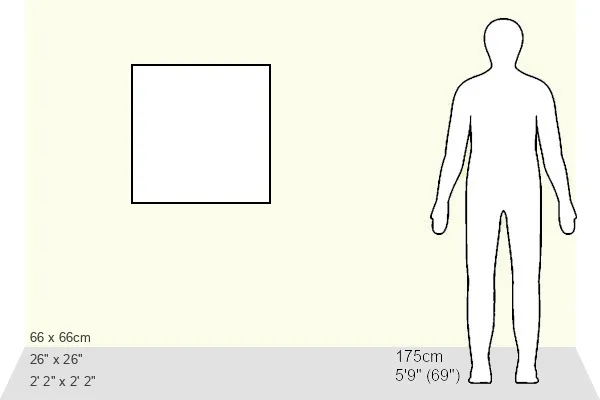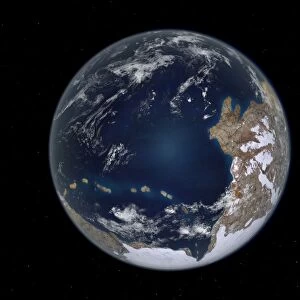Fine Art Print > Stocktrek Images > Space
Fine Art Print : The Western Interior Seaway as seen 75 million years ago from Earth orbit
![]()

Fine Art Prints from Stocktrek
The Western Interior Seaway as seen 75 million years ago from Earth orbit
This is how the Western Interior Seaway may have appeared 75 million years ago from Earth orbit. This large inland sea once divided the North American continent into two landmasses, Laramidia to the west and Appalachia to the east. Branching toward the northeast is the Hudson Seaway and to the north on the horizon are the liquid polar waters of the Labrador Seaway.
At less than one-fifth the size of present day North America, the island continent of Laramidia extended from present-day Mexico to Alaska and was home to tyrannosaurs, dromaeosaurids, troodontids, hadrosaurs, ceratopsians, pachycephalosaurs, and titanosaur sauropods.
The dinosaurs of Appalachia are less-understood as much of the fossil evidence was destroyed by the glaciers that alternately descended from the north and retreated starting 2.5 million years ago
Stocktrek Images specializes in Astronomy, Dinosaurs, Medical, Military Forces, Ocean Life, & Sci-Fi
Media ID 13057107
© Walter Myers/Stocktrek Images
Atlantic Ocean Beginnings Changing Form Continent Creation Earth Earth Science Fault Geography Geology Island Landform Landmass Life Lithosphere Merging Natural History North America Origin Pacific Ocean Paleogeography Physical Geography Planet Plate Tectonics Solar System Space Art Square Image Western Hemisphere Appalachia Continental Drift Cretaceous Evolution Mesozoic Era Prehistoric Era Seaway Subcontinent
20"x20" (+3" Border) Fine Art Print
Step back in time with Media Storehouse's Fine Art Prints and experience the awe-inspiring sight of Earth's past. Witness the Western Interior Seaway as it may have appeared 75 million years ago, as depicted in this stunning image by Walter Myers of Stocktrek Images. This large inland sea once divided the North American continent, creating a unique and fascinating geological landscape. Bring this piece of history into your home or office and inspire wonder with every glance. Our Fine Art Prints are of the highest quality, ensuring vibrant colors and sharp details that truly bring the past to life.
20x20 image printed on 26x26 Fine Art Rag Paper with 3" (76mm) white border. Our Fine Art Prints are printed on 300gsm 100% acid free, PH neutral paper with archival properties. This printing method is used by museums and art collections to exhibit photographs and art reproductions.
Our fine art prints are high-quality prints made using a paper called Photo Rag. This 100% cotton rag fibre paper is known for its exceptional image sharpness, rich colors, and high level of detail, making it a popular choice for professional photographers and artists. Photo rag paper is our clear recommendation for a fine art paper print. If you can afford to spend more on a higher quality paper, then Photo Rag is our clear recommendation for a fine art paper print.
Estimated Image Size (if not cropped) is 50.8cm x 50.8cm (20" x 20")
Estimated Product Size is 66cm x 66cm (26" x 26")
These are individually made so all sizes are approximate
Artwork printed orientated as per the preview above, with landscape (horizontal) or portrait (vertical) orientation to match the source image.
EDITORS COMMENTS
This print takes us back in time, 75 million years ago, to witness the awe-inspiring Western Interior Seaway from Earth's orbit. As we gaze upon this ancient landscape, we can imagine how this vast inland sea once divided the North American continent into two distinct landmasses. To the west lies Laramidia, a sprawling island continent stretching from present-day Mexico all the way to Alaska. This vibrant and diverse region was teeming with life, hosting an array of magnificent dinosaurs such as tyrannosaurs, dromaeosaurids, troodontids, hadrosaurs, ceratopsians, pachycephalosaurs, and titanosaur sauropods. On the eastern side of the seaway stood Appalachia. Unfortunately, much of our knowledge about its prehistoric inhabitants remains elusive due to extensive destruction caused by glaciers that advanced and retreated over millions of years. As we explore further into this mesmerizing image captured by Walter Myers for Stocktrek Images' collection on earth's natural history and evolution; we catch sight of other intriguing features. Branching towards the northeast is the Hudson Seaway while on the distant horizon lie the liquid polar waters of Labrador Seaway. With its rich geological history encompassing plate tectonics and continental drifts shaping our planet's past formative stages; this photograph serves as a window into Earth's ancient origins. It reminds us that even within our familiar world today lies a hidden tapestry woven through time - one that reveals both continuity and change in our ever-evolving planet.
MADE IN THE USA
Safe Shipping with 30 Day Money Back Guarantee
FREE PERSONALISATION*
We are proud to offer a range of customisation features including Personalised Captions, Color Filters and Picture Zoom Tools
SECURE PAYMENTS
We happily accept a wide range of payment options so you can pay for the things you need in the way that is most convenient for you
* Options may vary by product and licensing agreement. Zoomed Pictures can be adjusted in the Cart.











